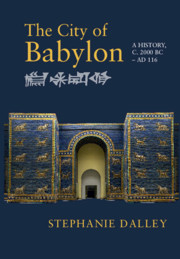Book contents
- The City of Babylon
- The City of Babylon
- Copyright page
- Contents
- Illustrations and Maps
- Preface
- Conventions
- Timeline
- Written Languages and Their Scripts
- 1 Land and Peoples
- 2 Discoveries and Excavations
- 3 First Kings to the End of the Great Rebellion, c. 1894–c. 1732
- 4 Law, Education, Literature, and the Path to Supremacy
- 5 From the Great Rebellion to the End of the First Dynasty, c. 1732–1592
- 6 The Next Six Centuries
- 7 In the Shadow of Assyria, 978–625
- 8 Empire
- 9 From the Death of Nebuchadnezzar II to the Death of Cambyses, 561–522
- 10 Darius I to Alexander, and Seleucid to Parthian Rule
- 11 First Parthian Conquest, 141 BC, to the Visit of Trajan in AD 116
- Appendix: Genesis 14:1–16 and Possible Links with Foreign Rulers Early in the Reign of Hammurabi
- Bibliography
- Index
11 - First Parthian Conquest, 141 BC, to the Visit of Trajan in AD 116
Published online by Cambridge University Press: 23 June 2021
- The City of Babylon
- The City of Babylon
- Copyright page
- Contents
- Illustrations and Maps
- Preface
- Conventions
- Timeline
- Written Languages and Their Scripts
- 1 Land and Peoples
- 2 Discoveries and Excavations
- 3 First Kings to the End of the Great Rebellion, c. 1894–c. 1732
- 4 Law, Education, Literature, and the Path to Supremacy
- 5 From the Great Rebellion to the End of the First Dynasty, c. 1732–1592
- 6 The Next Six Centuries
- 7 In the Shadow of Assyria, 978–625
- 8 Empire
- 9 From the Death of Nebuchadnezzar II to the Death of Cambyses, 561–522
- 10 Darius I to Alexander, and Seleucid to Parthian Rule
- 11 First Parthian Conquest, 141 BC, to the Visit of Trajan in AD 116
- Appendix: Genesis 14:1–16 and Possible Links with Foreign Rulers Early in the Reign of Hammurabi
- Bibliography
- Index
Summary
Early attempts by Parthian rulers to take Babylon were short-lived, but in 141 BC they established their kingship by celebrating the New Year festival. Chronicles and astronomical diaries continued to be written. An independent ruler of Maysan in the Sealand, Hyspaosines, captured the port on the Tigris, took control of Bahrain and Failaka to control Gulf trade, and briefly claimed kingship of Babylon. He wrote in Aramaic. The Parthians regained control and rebuilt the Greek theatre. The old buildings and city plan continued to be in use, although the Summer Palace had been reroofed with terracotta tiles. New kinds of text were written on clay in cuneiform, astronomical science developed; an archive shows that temples were still active, and much older literature was still prized. Greek knowledge of the Epic of Creation was still alive in Athens from the time of Alexander until the sixth century AD. The cult of Bēl had spread west to Palmyra, to the Aegean island of Kos, and north to Edessa. In AD 116 Trajan visited the Summer Palace on a pilgrimage to the place where Alexander had died.
Keywords
- Type
- Chapter
- Information
- The City of BabylonA History, c. 2000 BC – AD 116, pp. 308 - 318Publisher: Cambridge University PressPrint publication year: 2021

